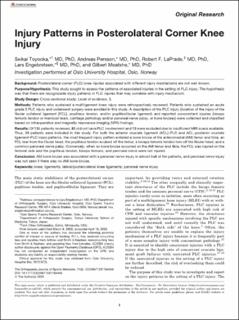| dc.contributor.author | Toyooka, Seikai | |
| dc.contributor.author | Persson, Andreas | |
| dc.contributor.author | LaPrade, Robert F. | |
| dc.contributor.author | Engebretsen, Lars | |
| dc.contributor.author | Moatshe, Gilbert | |
| dc.date.accessioned | 2024-02-09T09:40:59Z | |
| dc.date.available | 2024-02-09T09:40:59Z | |
| dc.date.created | 2023-12-07T14:20:20Z | |
| dc.date.issued | 2023 | |
| dc.identifier.citation | Orthopaedic Journal of Sports Medicine. 2023, 11(8), Artikkel 23259671231184468. | en_US |
| dc.identifier.issn | 2325-9671 | |
| dc.identifier.uri | https://hdl.handle.net/11250/3116552 | |
| dc.description | This open-access article is published and distributed under the Creative Commons Attribution - NonCommercial - No Derivatives License (https://creativecommons.org/licenses/by-nc-nd/4.0/), which permits the noncommercial use, distribution, and reproduction of the article in any medium, provided the original author and source are credited. You may not alter, transform, or build upon this article without the permission of the Author(s). | en_US |
| dc.description.abstract | Background: Posterolateral corner (PLC) knee injuries associated with different injury mechanisms are not well known.
Purpose/Hypothesis: This study sought to assess the patterns of associated injuries in the setting of PLC injury. The hypothesis was that there are recognizable injury patterns in PLC injuries that may correlate with injury mechanism.
Study Design: Cross-sectional study; Level of evidence, 3.
Methods: Patients who sustained a multiligament knee injury were retrospectively reviewed. Patients who sustained an acute grade 3 PLC injury and underwent surgery were enrolled in this study. A description of the PLC injury (location of the injury of the fibular collateral ligament [FCL], popliteus tendon, and/or popliteofibular ligament) and reported concomitant injuries (biceps femoris tendon or meniscal tears, cartilage pathology and/or peroneal nerve palsy, or bone bruises) were collected and classified based on intraoperative and magnetic resonance imaging (MRI) findings.
Results: Of 135 patients reviewed, 83 did not have PLC involvement and 13 were excluded due to insufficient MRI scans available. Thus, 39 patients were included in this study. For both the anterior cruciate ligament (ACL)–PLC and ACL–posterior cruciate ligament–PLC injury patterns, the most frequent injury pattern entailed a bone bruise of the anteromedial (AM) femur and tibia, an FCL tear from the fibular head, the popliteus tendon avulsed off the femur, a biceps femoris tendon torn off the fibular head, and a common peroneal nerve palsy. Conversely, when no bone bruise occurred on the AM femur and tibia, the FCL was injured on the femoral side and the popliteus tendon, biceps femoris, and peroneal nerve were not injured.
Conclusion: AM bone bruise was associated with a peroneal nerve injury in almost half of the patients, and peroneal nerve injury was not seen if there was no AM bone bruise. | en_US |
| dc.language.iso | eng | en_US |
| dc.subject | knee | en_US |
| dc.subject | lateral knee ligaments | en_US |
| dc.subject | ligaments | en_US |
| dc.subject | peroneal nerve injury | en_US |
| dc.subject | posterolateral knee ligaments | en_US |
| dc.title | Injury patterns in posterolateral corner knee injury | en_US |
| dc.type | Peer reviewed | en_US |
| dc.type | Journal article | en_US |
| dc.description.version | publishedVersion | en_US |
| dc.rights.holder | © The Author(s) 2023 | en_US |
| dc.source.pagenumber | 7 | en_US |
| dc.source.volume | 11 | en_US |
| dc.source.journal | Orthopaedic Journal of Sports Medicine | en_US |
| dc.source.issue | 8 | en_US |
| dc.identifier.doi | 10.1177/23259671231184468 | |
| dc.identifier.cristin | 2210425 | |
| dc.description.localcode | Institutt for idrettsmedisinske fag / Department of Sports Medicine | en_US |
| dc.source.articlenumber | 23259671231184468 | en_US |
| cristin.ispublished | true | |
| cristin.fulltext | original | |
| cristin.qualitycode | 1 | |
